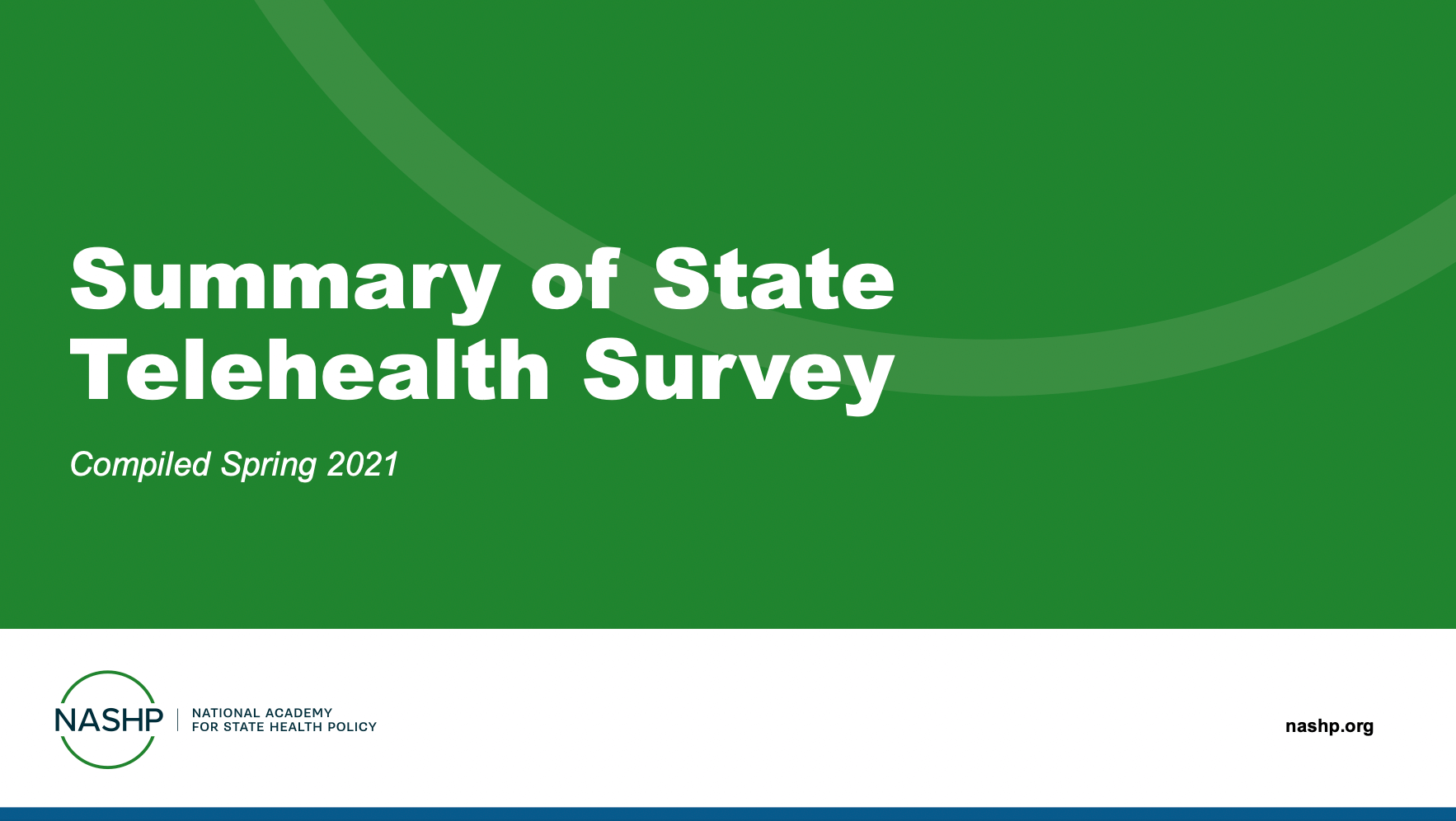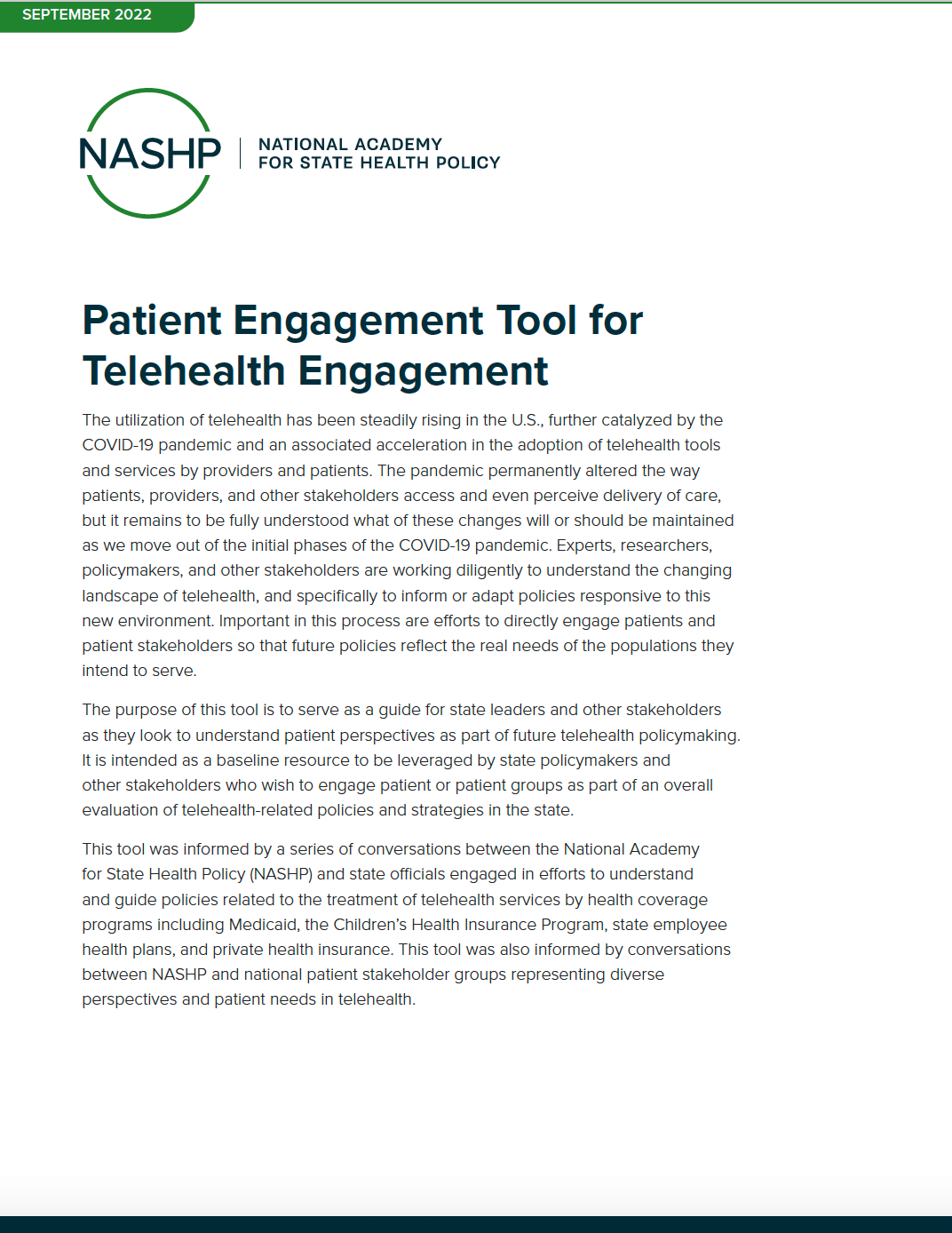With support from a Patient-Centered Outcomes Research Institute (PCORI) award, the National Academy for State Health Policy (NASHP) engaged state officials representing Medicaid, the Childrens Health Insurance Program (CHIP), state-based marketplaces (SBMs), state employee health plans (SEHPs) and insurance departments, as well as key patient and advocate groups to learn more about how rapid changes to telehealth during COVID-19 might be sustained or not. Without question, the relaxation of previous telehealth restrictions at the federal and state level expanded access to virtual health services including primary care, chronic disease, prescription drug management, and more. It also ushered in the use of consumer-friendly technology, such as using personal mobile phones to connect with physicians, which increases convenience for many patients. However, it also raises important questions that state legislators and program officials need to address. Will audio-only doctor visits and FaceTime video chatting continue to be reimbursed as if they are in-person service visits, and should they? Should telehealth providers, located out of a state but who are available for virtual visits, be used to meet network adequacy requirements for a health plan?
NASHP sought to bring the patient perspective on telehealth to state official discussions as they seek to develop long-term telehealth policy within their own coverage programs and for the broader state. While there arent simple answers, the different perspectives are valuable. Themes of multiple discussions are shared in this brief, as are resources to help inform telehealth policymaking across states.
Balancing Telehealth Access
There is agreement across state officials and patient groups that broad telehealth expansion was needed throughout COVID to ensure access to health services was available. However, what telehealth looks like post-pandemic may not be as straightforward. Ultimately, state officials want to ensure patients have access to high-quality care that results in good health outcomes. While many, including PCORI, are investing in research to understand if services delivered by telehealth provide the same quality level (or better) of care delivered in-person, it is still early to have meaningful supportive evidence for policymaking.
As is typical, the ever-changing health landscape requires policy decisions before there is time to appropriately research and document findings to offer influential evidence. State officials are analyzing their own data, including claims and quality metrics, as well as seeking input directly from patients in a variety of ways from surveys to public comments. Some states are making legislative decisions that include telehealth payment parity to ensure services provided remotely are paid the same rate as are in-person services. While others are requiring providers maintain office space to meet with patients in-person so that all care isnt shifted to the virtual setting.
Patient Feedback on Telehealth
NASHP convened a virtual focus group of national and state level patient representatives to learn more about the patient experience using telehealth throughout the pandemic and as in-person services were resuming. The following are some of the key themes that were shared from that discussion:
- Telehealth allows for culturally appropriate care from safe settings. For some patients whose primary language is not English and who are part of immigrant communities, accessing health services from home feels safer than doing so in person. Language was not reported as a barrier in accessing care and connecting with a provider from home offered significant benefits that encouraged regular care for prevention and chronic disease management.
- Multiple different telehealth technologies can be challenging for patients, but still more convenient than traveling to different offices. Patients with special health care needs may require services from several different providers on a regular basis and each of those providers may use a different technical system for telehealth visits. Mastering different telehealth platforms adds to the level of technical complexity patients experience meeting with their different providers. But reducing the travel time to meet with multiple providers in-person is not only more convenient but saves a lot of time for patients and their families. However, ideally, there would be a closer to universal telehealth system to streamline the experience for patients, and it would likely benefit providers as well.
- Privacy is critical when communicating with health providers and it could be lacking for some patients using telehealth. Not all patients have broadband internet to their homes and instead must use public wifi, which is not ideal for telehealth visit. Even patients with stable, home-based broadband, may not a have a private room to use when speaking virtually with their provider and so the visit is not confidential. The provider on the other end of the device may not know that information is being withheld from them by their patient. Lack of privacy can dictate the value of a telehealth visit for a patient. For instance, it was shared that some young adults participating in telehealth services, including but not exclusively related to mental health, withheld critical information from their provider for fear a parent would overhear the conversation. If the young adult patient had been in a private setting with their provider, they would likely have shared more details. However, its not known if the care the patient received would have been different or not.
Ultimately, the patient focus group feedback was very positive about the increased availability and use of telehealth. There was overwhelming support across the patient representatives for the flexibilities allowed during COVID to be continued. This is true even though not all patients can benefit from the increased access in same way for every telehealth visit. Further, there is a recognition that not all care should be provided virtually and a mix of service options with some assistance from trusted providers on when to meet in-person versus by telehealth would be ideal.
State Official Feedback on Telehealth
NASHP convened separate conversations with officials representing specific state coverage programs, including Medicaid, CHIP, SEHPs, as well as SBMs and departments of insurance that provide oversight of the individual and small group markets. They spoke of some challenges to ensuring telehealth was available, but ultimately shared patients views of its success in ensuring access to care during COVID. The following are some key themes from the conversations with states about telehealth and how to handle it moving ahead:
- Telehealth is convenient. State officials are patients too and several of them shared how much they personally value the convenience of telehealth to connect with their own providers. Others spoke from their perspective as employers and shared the benefit that their staff does not need to take entire days off for one provider appointment anymore, which has helped with productivity. Of course, officials also expressed the value to the patients they serve and referenced direct feedback they continue to receive about the benefits people are experiencing using telehealth.
- States are grappling with how to ensure value as demand and utilization of telehealth services remains high. Across all programs, there was a significant increase in telehealth utilization, particularly for behavioral health services. By and large, this increase was seen positively, particularly for SEHP programs because as some officials noted these services were under-utilized pre-pandemic. However, officials also recognized that not all increases in utilization are positive and without more information on quality, its unknown if telehealth services are supporting good health outcomes or simply increasing the number of services and thereby costs.
- State officials must consider the entirety of the health care market when seeking to ensure access to services for patients. Officials recognize that not all health care providers have been able to participate in telehealth services because there is a technology cost for the provider. Some state officials observed independent providers have been enticed and acquired by larger health systems because they have telehealth technology for all their owned providers. One theme of discussion across state calls was that telehealth can easily be swapped for simple questions, follow-up, or routine visits to primary care providers. For instance, telehealth is a convenient way to follow up with a primary care doctor who prescribed a new medication that is working for the patient or when a patient comes down with an annual sinus infection and needs prescription cough medicine. But if the low hanging fruit of medical care is moved to virtual visits and away from independent providers that dont offer telehealth, how will that impact already struggling providers? Will losing independent providers ultimately hurt access to affordable primary care for patients?
For state officials, the answer to these questions is not simply to continue or alter telehealth policy perimeters. But instead, consider how other policies could support the changing health provider landscape. One SEHP administrator shared their program now encourages patients to use telehealth with a primary care provider for joint injuries (i.e., ankle or knee sprains, twists, etc.) rather than going to an urgent care visit. Evidence supports that a video chat (via mobile phone or computer) is sufficient for a physician to assess if further diagnostics and treatment is needed, such as an X-ray, cast, etc. Not only does this practice save the health plan and the patient money, as urgent care is expensive, but it keeps the patient from an unnecessary medical appointment. State officials responsible for overseeing coverage programs, may find other similar opportunities for using telehealth to increase efficiency and while reducing costs.
Informing Telehealth Policy Decisions
In assessing our most recent telehealth experiences, both patients and policymakers are asking – is all access equal? While PCORI invests in research to help answer that question, state officials are seeking input to understand patient experiences using different forms of telehealth (mobile videoconferencing vs. audio-only). With input and assistance from Family Voices and PCORI resources, NASHP developed a patient engagement tool that states can use or adapt to collect feedback directly from those participating in telehealth services. Also, there is a growing body of patient-centered outcomes-based research that can be leveraged to inform post COVID telehealth decision making.
Conclusion
State policymakers and patients are both seeking to ensure quality access to health care, which is critically important. While patient preferences in accessing care is important, state officials must also ensure decisions related to telehealth policy dont adversely impact the availability of in-person services. Officials must also consider the potential impact to the broader health market, which includes different kinds of providers (multiple physician practices, as well as small single doctor offices) delivering different kinds are care (primary care, behavioral health, and specialty services) to different types of patients. As is usual, state policymakers are challenged to balance competing demands that have short- and long-term implications without having all the information needed. Its likely that states will make iterative policy relating to telehealth now and for years to come as more information about quality of care, access to in-person and telehealth services, cost, and health outcomes become available.
 Slide deck: Summary of State Telehealth Survey
Slide deck: Summary of State Telehealth Survey
Patient Engagement Tool for Telehealth Engagement




